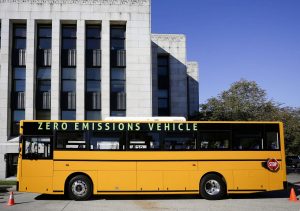Australia’s wildfires are burning with such intensity that they’re sparking contained, small-scale weather systems. Thunderstorms triggered by atmospheric disturbance might at first seem to offer relief in the form of raindrops, but instead, bolts of lightning can strike nearby trees and spread the fire even further than before.
Wired UK
This story originally appeared on WIRED UK.
This is a small-scale example of an environmental feedback loop—where conditions on the ground trigger a self-perpetuating chain of events. Wildfires pump vast amounts of carbon dioxide into the atmosphere, heating up the planet in the short term. But are wildfires helping to accelerate climate change or just a deadly consequence of a more extreme climate?
Since September, hundreds of fires across Australia have engulfed more than 6.3 million hectares of land. Villages have been razed and 25 people killed so far. Months of hot, dry weather and strong winds created the perfectly deadly conditions that keep conflagrations roaring. There were at least twice as many fires in New South Wales in 2019 as there were in any other year this century.
There are a couple of ways increasingly severe wildfire seasons could speed up global climate change. In the months immediately following wildfires, the volume of CO2 in the world’s atmosphere increases, magnifying the heat trapped there. “Wildfires create a substantial contribution, because they happen in places like the Amazon rain forest and the peat bogs in Indonesia, which contain a lot of carbon,” says Colin Prentice, director of the Leverhulme Centre for Wildfires at Imperial College London. The ongoing Australian fire season has released more than 350 million metric tons of CO2 so far, with fires expected to keep burning over the next two months.
Fires also throw up clouds of soot into the atmosphere, which compounds the problem. “Black carbon is the most strongly light-absorbing material from fires, and it is regarded as one of the most important individual climate-warming agents,” Yafang Cheng, a researcher from the Max Planck Institute for Chemistry in Mainz, Germany, told WIRED in November 2018. These particles can float up into the upper layers of the atmosphere where they exert an even greater heating effect—and hang around for months.
But there are longer-term effects too. In more typical wildfire cycles, the vegetation that burns is usually replaced by the same type of plant life. But longer and more severe fire seasons—as we’re seeing in many parts of the world—means it’s becoming more difficult to predict what type of vegetation will spring up in place of the freshly incinerated ecosystems. “If the frequency and intensity of fires begins to change, then you’re probably going to change the character of the vegetation as well—toward one that is adapted to more frequent fires,” says Prentice.
What type of vegetation might grow back after the Australian wildfires is still uncertain. But there’s a chance that the form it takes could increase the likelihood of future infernos. A 2017 study published in the journal Global Change Biology that examined fauna in the Australian Alps found that one of the first plant species to grow back in the area after wildfires was woody shrubs. Worryingly, these were more flammable than the feathery tussock grasses that had previously colonized the land. One caveat to consider though, is that in the years following an extreme fire, there will simply be less vegetation to burn the next time around—meaning a future blaze would be less intense.
None of this bodes well for the future. But there are other factors at play too. “In short, it’s not as simple as ‘more fires cause more fire danger,’” says Park Williams, assistant research professor at the Lamont-Doherty Earth Observatory at Columbia University.
“It’s not really a dominant mechanism,” Prentice says of the fire-climate change feedback loop. “It’s a mechanism that does exist, and we can quantify it in the sense that if there are a lot of fires globally in a particular year, that does mean the total biomass on land has gone down a bit, and some of that carbon is going to stay in the atmosphere. But it’s probably fair to say it’s a secondary effect.” The most important effect being, of course, that we emit millions of metric tons of CO2 into the atmosphere every year, and half of it remains there.
Although less plant life means less photosynthesis (and therefore less CO2 being converted to oxygen) in the short term, vegetation eventually grows back. “More important than one big fire year is the question, what is going to happen to the biomass of plants on the continents in the future warmer world?” says Williams.
While we generally focus on the negative effects of climate change, one positive is that the rate of plant growth has actually sped up along with accelerating global temperatures. Satellite imagery shows that global plant productivity and biomass has increased over the past several decades due to longer growing seasons in cold places, more agricultural productivity, and increasing CO2—which is, after all, one of the fundamental fuels for plant growth.
Right now, global plant life handily gobbles up between 25 and 30 percent of the world’s annual CO2 emissions. But in time, warming and increased CO2 output might put a dent in this oxygen-gifting process. “We don’t know what will happen, and that’s partly because of fire,” says Williams. Fire adds an element of unpredictability—the possible effects on global ecosystems are hard to calculate right now.
“Wildfires, particularly these kind of fires, are what is termed a ‘wicked’ problem,” says Claire Belcher, professor and chair in wildland fire at the University of Exeter. “There is no single cause and no single solution, and they require a shift in our thought patterns. Climate change is a large forcing factor in regards to these fires, but it is not the only cause, and facing it is not the only solution.”
And although the number of wildfires has increased in recent decades, historically some human activities have helped curtail the concentration of blazes. “By creating cropland, and having fairly intense grazing that removes all the biomass, you are also removing the fuel,” says Prentice.
No one is going to suggest large-scale deforestation as a potential solution to wildfires any time soon. But on the other hand, indiscriminate reforestation could also pose a problem. “Many governments are keen on the idea of resolving climate change by planting trees—but, you know, trees can burn,” says Prentice. As well as a wicked problem, wildfires are also be fiendishly difficult to predict. We know that global warming increases the likelihood of fires—but we need more evidence before concluding the reverse too.
This story originally appeared on WIRED UK.
More Great WIRED Stories
- Hollywood bets on a future of quick clips and tiny screens
- Mind control for the masses—no implant needed
- Here’s what the world will look like in 2030 … right?
- Internet deception is here to stay—what do we do now?
- The war vet, the dating site, and the phone call from hell
- 👁 Will AI as a field “hit the wall” soon? Plus, the latest news on artificial intelligence
- 🏃🏽♀️ Want the best tools to get healthy? Check out our Gear team’s picks for the best fitness trackers, running gear (including shoes and socks), and best headphones



